Many users cropped cameras often complain that it’s difficult to get a good picture from such a camera and that you must use full frame. Many people just drool on full-frame camerasthinking that they can do something improve their photos. And if you really want to shoot a full frame, and at the same time invest a little bag of money to purchase a camera, then this article is just for you.
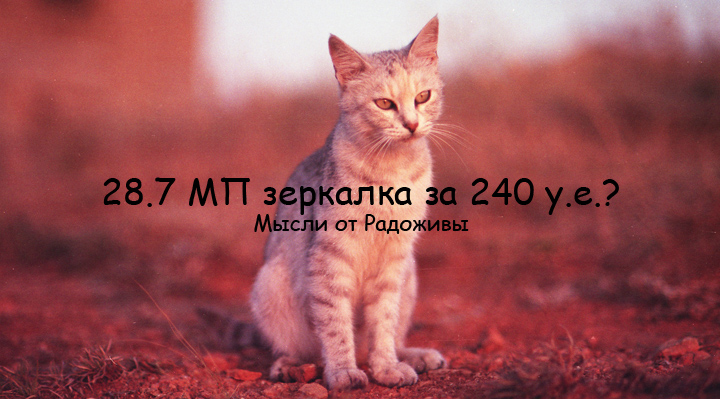
Shot on the same Full Frame :) 28 MP for 240 cu The cat is photographed in the sunset red sun.
Any good photography is based on the desire and skill of the photographer, everything else (including photographic equipment) is just a distraction from the main goal. I am often reproached for advocating to shoot with cheap equipment. I don’t actually do that, I advocate the idea that you can get a good shot from any camera if you want. Of course, the better the technique, the easier and faster the result can be achieved. Those who want to get good pictures get them from anyone, sometimes even the cheapest technique.
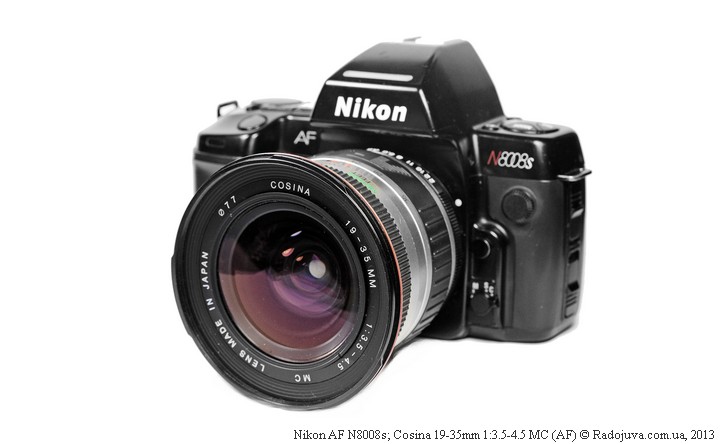
Actually, in this photo almost the whole essence of the article :)
Therefore, if there is a key aspect - desire, then for only 240 cu can:
Shoot with a full-frame SLR camera, with fast automatic focus, good serial shooting with a huge frame buffer, a huge optical viewfinder, nice controls and at the same time take pictures at 28 MP.
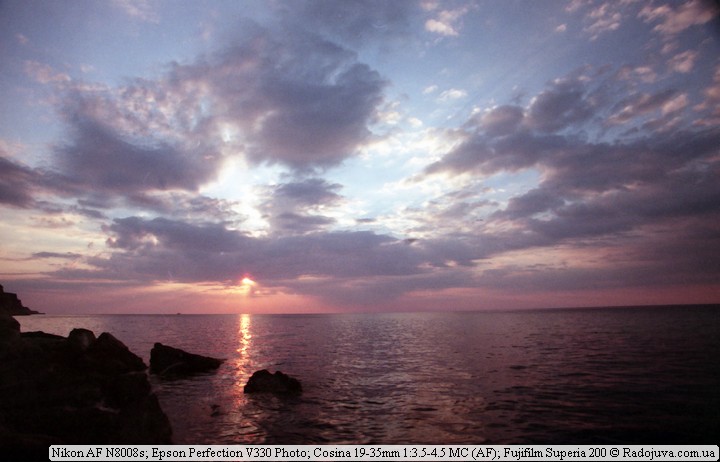
Example photo on my set. Sunset.
The secret is very simple - just use a film camera.
Many readers may think that the film camera is something terribly ancient, incomprehensible to manage, morally obsolete and unsuitable for use in the era of modern monsters Nikon D4 and Canon 1DX. In the expanses of the CIS countries such an impression people have it from the fact that in the Union and on its territory not a single SLR narrow-camera camera with automatic focus was released. Seriously, the old Zeniths do not cause any interest among young people, the main reason for which is the complete obsolescence of technology.
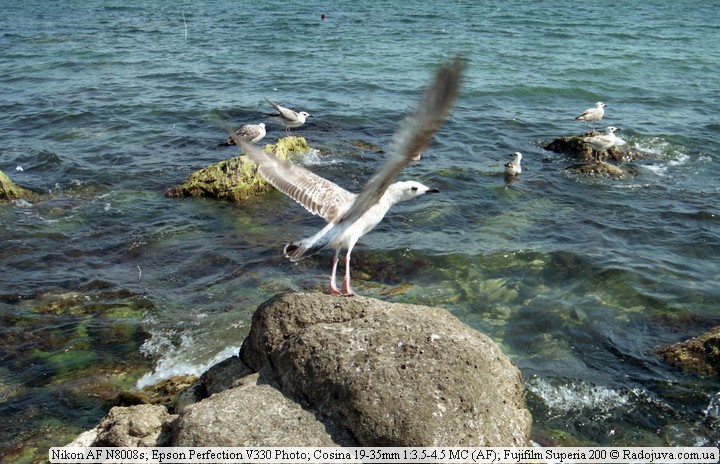
Example photo on my set. Gull
But in other countries long ago let out pretty autofocus analog volatile DSLRs with interchangeable lenses. Moreover, using such a SLR camera is no different from any modern amateur DSLR camera. Nikon D3200 or Canon 600D.
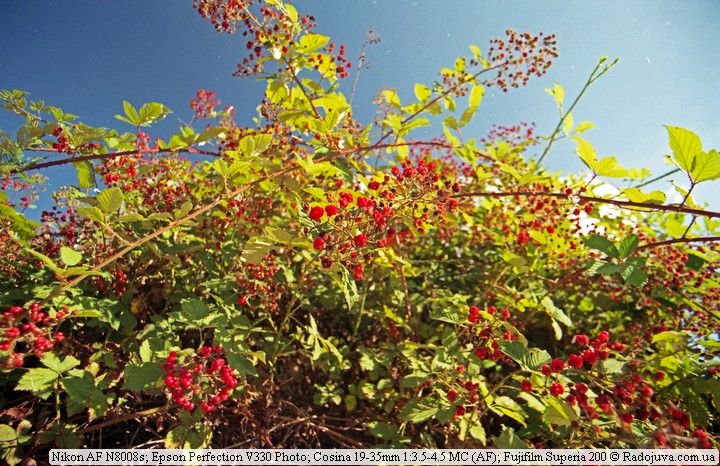
Example photo on my set. Forest Blackberry
I conducted an experiment, which cost me quite inexpensively, as a result of which this kit was assembled here:
- Nikon AF N8008s (also known as Nikon AF F801s) - 400 UAH
- Cosina MC 19-35mm 1: 3.5-4.5 (AF) - 700 UAH
- AA Batteries * 4 - 20 UAH
- 200-frame Fujifilm Superia 36 film roller - 27 UAH with free development
- Epson Perfection V330 Photo Scanner - 650 UAH
- Shipping of the camera, lens and scanner - 80 UAH
Total 1877 UAH or 235 cu In fact, I could save on the lens and batteries, since I have both. The camera, film roll and scanner cost me some 140 cu
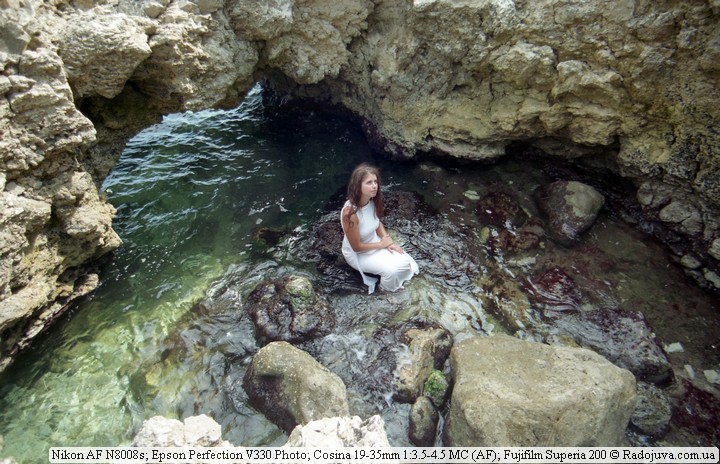
Example photo on my set. Among the stones
As a result, I got:
- A full-frame camera with a shooting speed of 3.3 frames per second. Some amateur cameras have approximately the same shooting speed. Nikon D80, D70s, D3000, D3100, and some professional CZK for 500 cu they shoot even slower, for example, Fujifilm Finepix S5 Pro.
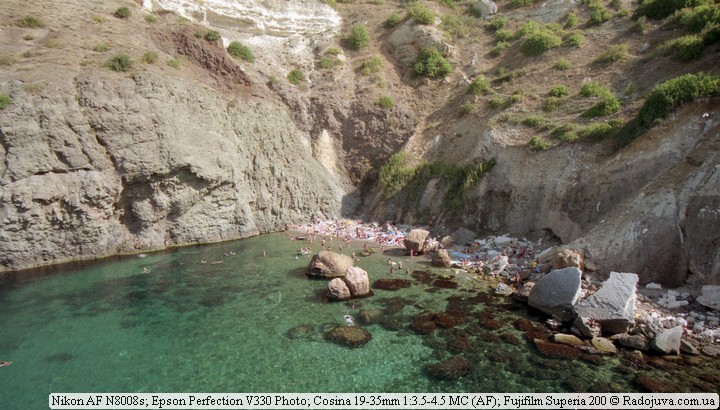
An example of a photo on a film camera. Beach.
- Maximum frame buffer makes 36 shots, for example, Nikon D7100 with the highest quality has frame buffer only 6 shots (RAW, 14-bit, lossless compression).
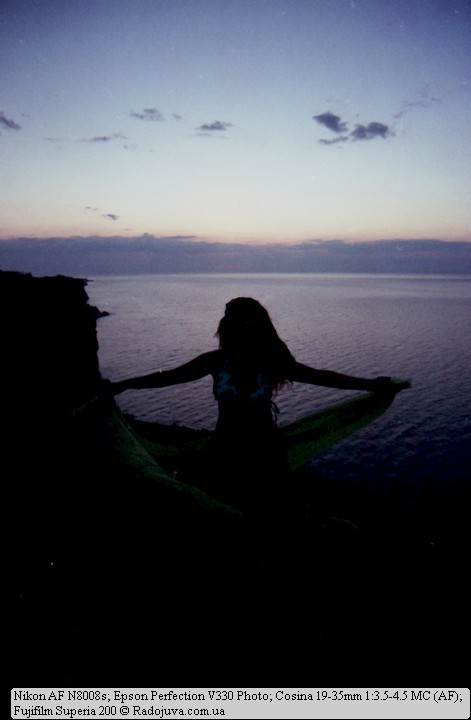
An example of a photo on a film camera. After sunset
- My camera can work out super short shutter speed equal to 1/8000 seconds, which even can not Nikon D600 и Canon 6D.
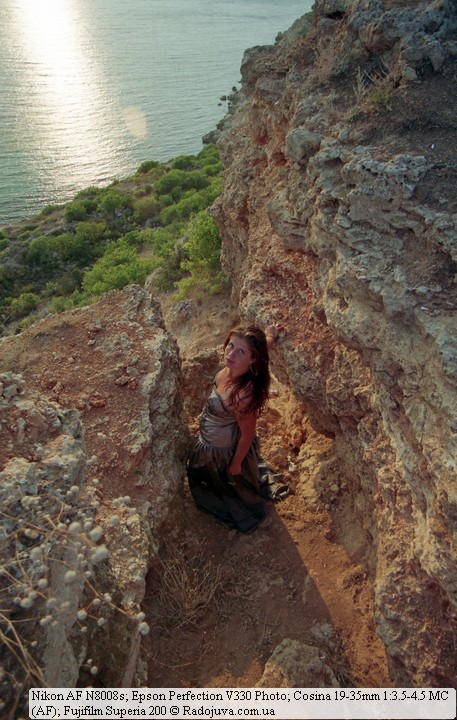
Example photo on my set. Among the stones
- A huge optical viewfinder that never dreamed Canon 70D for 1500 cu Yes, and in itself Nikon AF N8008s very good and durable camera.
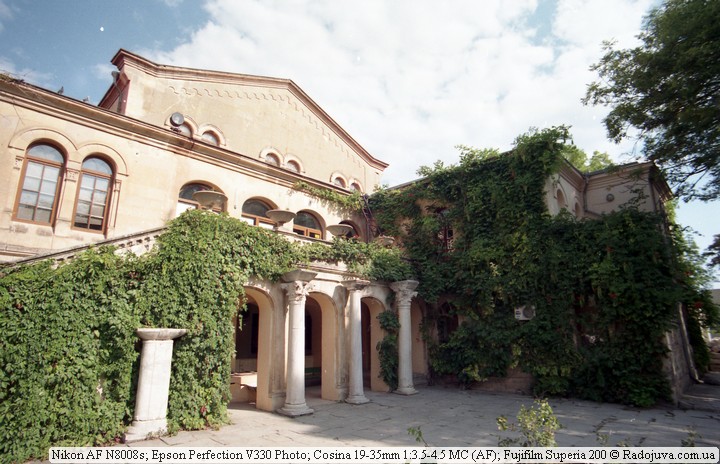
An example of a photo on a film camera. House overgrown with grapes.
- My Nikon AF N8008s it works easily with manual optics - it correctly measures exposure, has an electronic range finder, which very accurately tells about focusing. Even Nikon D5200 for 600 cu can't measure exposure with AI-S lenses.
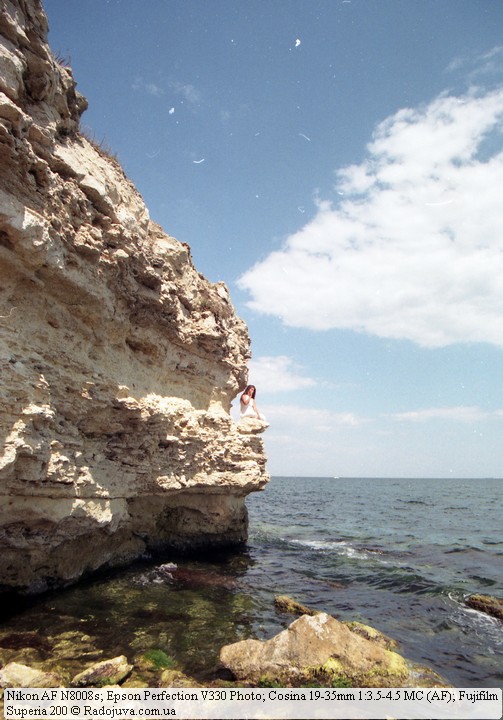
An example of a photo on a film camera. Sitting on the rocks.
- Very nice LCD in JVI, its brightness is physically (not electronically) dependent on the light source. The brighter the source - the brighter the LCD, which allows you to always clearly see the camera settings in JVI. For example, on many CZKs, I don’t see the LCD at all on a bright day or when shooting in backlight.
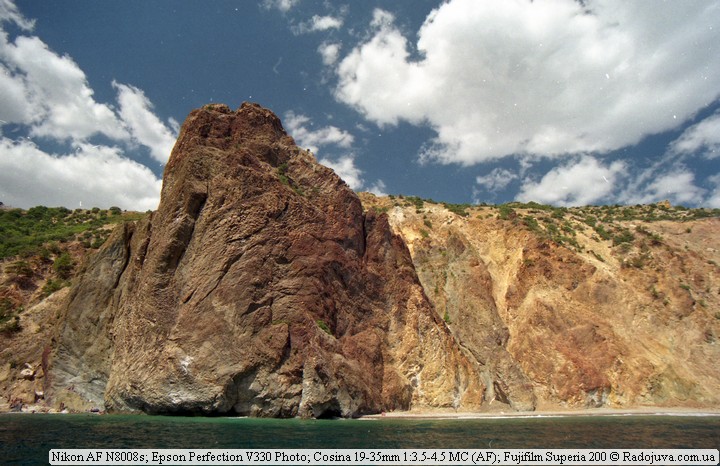
Example photo on my set. Photo from the boat
- Camera control is almost the same as that of any other Nikon CZK. When shooting, you don’t feel any difference, the whole setup is on a monochrome display.
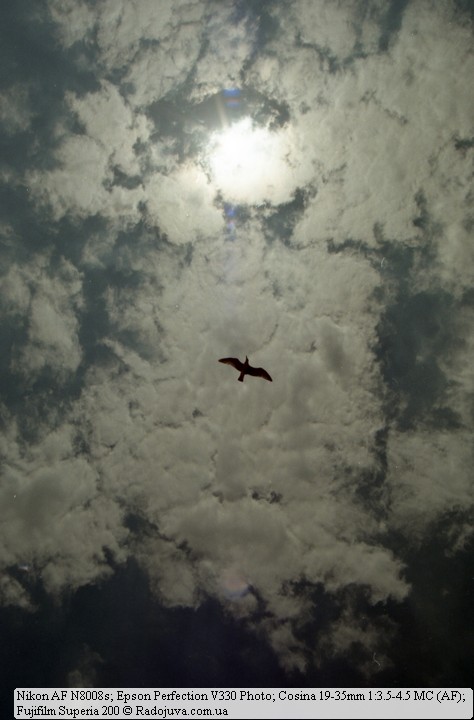
An example of a photo on a film camera. Gull
- Lens Cosina MC AF 19-35mm 1: 3.5-4.5 I just bought it for fun. 19mm at full frame can be safely attributed to an ultra-wide range of focal lengths. The lens focuses terribly fast, and with it you can create amazing pictures. To get the same viewing angle as this cheap lens gives out, on Nikon cropped cameras you should use the expensive Nikon 12-24mm F / 4.0.
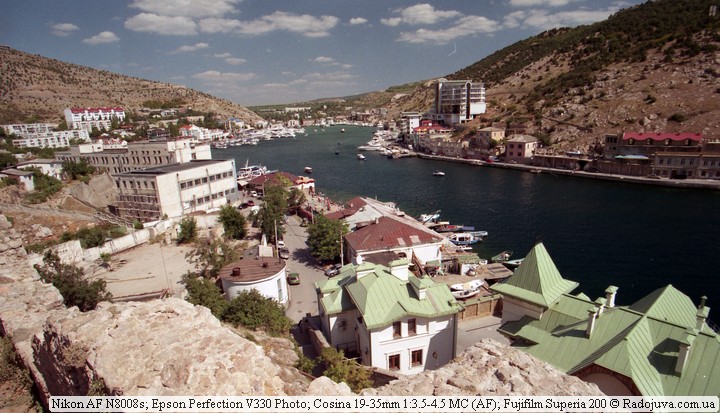
Example photo on a film camera
- A scanner in the house is also useful, for example, to digitize old photographs for an album. For example, you can scan your school diaries, and share old memories on social networks. In any case, the scanner will not be redundant.
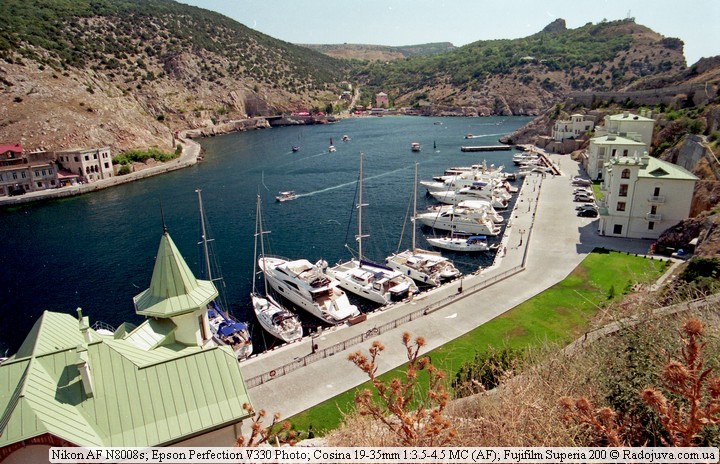
Example photo on my set. Yachts
- The scanner allows you to obtain images with 48-bit color depth. This means that each channel is encoded with 16 bits. Most 'cool modern cameras'can encode a channel using only 14 bits, and receive 42 bits at the output. Theoretically, with my scanner, you can get 64 times more shades than with any DCC.
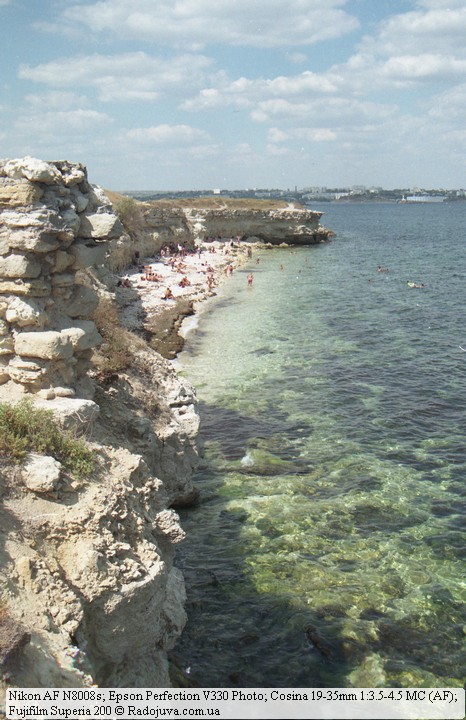
An example of a photo on a film camera. Shore
- Of course, my set has more disadvantages than advantages :), but I’ll keep silent about them in this article.
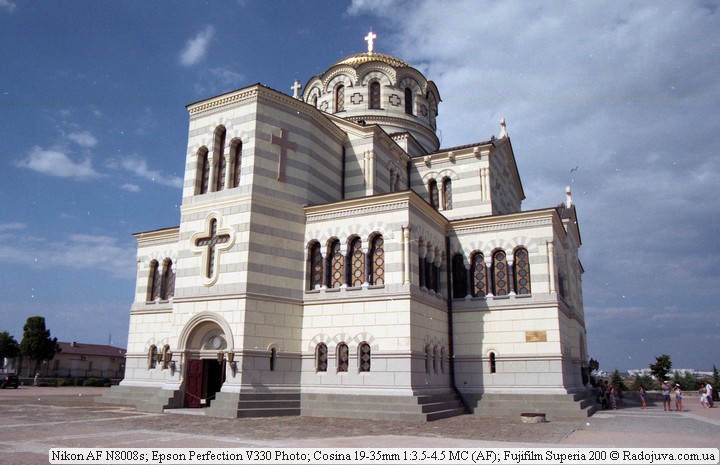
Example photo on my set. Temple in Chersonesos.
The following describes where I got 28 MP from the old film camera.
Of course, the 28MP figure in the article is a duck. But you can still get this figure in this way - the film has a physical frame size of 24mm * 36mm. Let's find the area of the film in square inches, since the parameters of the scanner are indicated in inches.
1 centimeter = 0.393700787 inches
1 square centimeter = 0.15500031000062 frame inches
1 square centimeter = 100 square millimeters
1 square millimeter = 0.0015500031000062 cpi
As a result, the film area is24mm * 36mm * 0.0015500031000062 = 1,339202678405357 sq. inch
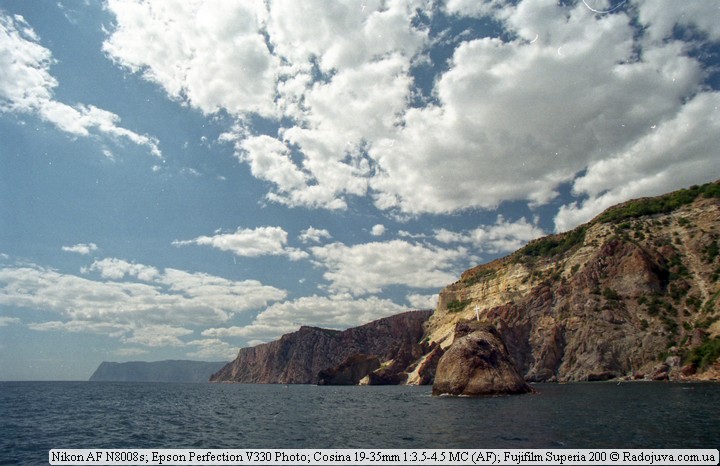
Example photo on my set. Landscape
The area of the film is 1,339202678405357 sq. inches. My scanner scans at 4800 pixels per inch, or 23 pixels per square inch. From 040 square inches of 000 pixels per square inch, 1,339202678405357 23 040 pixels are obtained, which is approximately equal to 000MP.
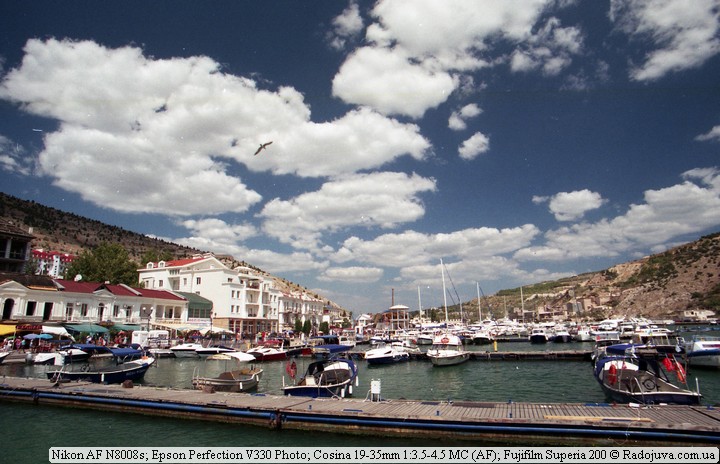
Example photo on my set. Balaclava
If your scanner has a different DPI, then the number of pixels when scanning a film frame can be calculated using the following simple formula:
DPI * DPI * 1,34
Some scanners in specifications have different DPI in height and width, for example, 4800 * 9600 is indicated in the specifications of my scanner. In fact, I can only scan at 4800 * 4800 or 9600 * 9600. The last option is half interpolation. The 'maximum possible DPI' is often indicated, for example 128000 is simply bloating the final image using a mathematical method of interpolating pixels, these numbers should not be paid attention to.
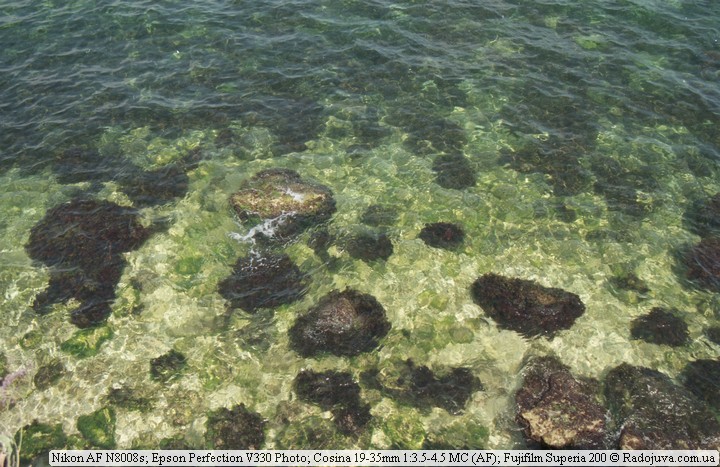
Example photo on my set. Near the shore
The simplest scanners with a slide adapter have 1200dpi, as a result, such a scanner can be squeezed out of one film shot:
1200 * 1200 * 1,34 = 1 929 600 (total about 2 MP)
I indicated '28MP camera' in the title of the article, since my Epson Perfection V330 Photo cuts off the edges of the frame a little when scanning and we end up with images not from the entire area of the film, but from a slightly smaller area. For example, a scanner often creates images like 6639 * 4319 pixels. Those who are chasing megapixels have already realized that from such a simple set you can squeeze these (or not these?) megapixels almost as much as Nikon D800 (a D800 costs almost 3000 cu).
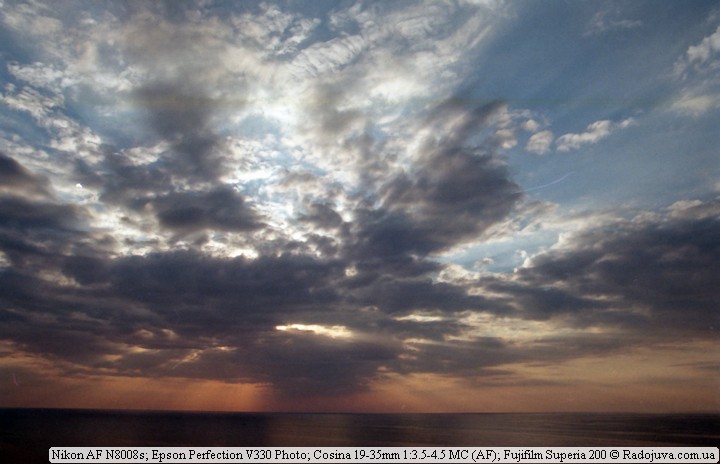
Example photo on my set. Another sunset
By itself, for serious work, such a set is no good. But the task before me was quite amateurish. For 240 cu I can enjoy a full-frame camera with convenient professional-grade control, an ultra-wide-angle lens that helped me out well on vacation and in addition I have a scanner that is convenient for scanning mail invoices :). I do not advocate fussing with a film camera, but once again I want to emphasize that there is absolutely no difficulty in working with a good analog camera. And instead of being discouraged that someone full frame, you can easily and simply shoot a full frame yourself.
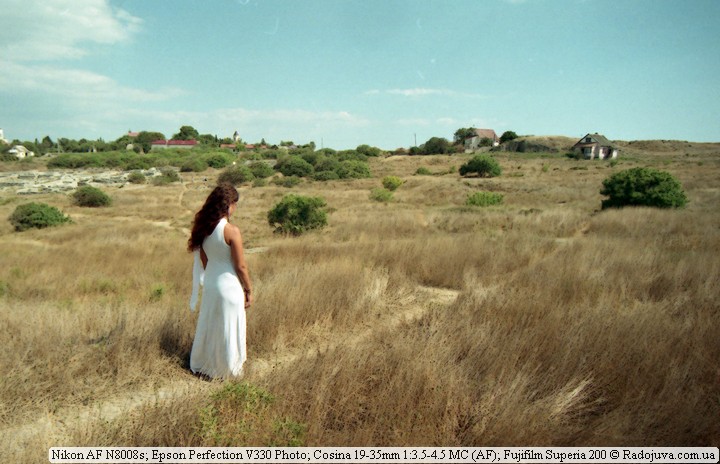
Example photo on my set. Road.
More sample photos (1400 pixels long)
Conclusions:
All of the above applies not only to my set. I brought my film set as real worldly example. Now buy used Nikon or Canon's autofocus analog camera is easy, the same goes for good-old lenses. The same story with the scanner.
Comments on this post do not require registration. Anyone can leave a comment. Many different photographic equipment can be found on AliExpress.
Material prepared Arkady Shapoval. Training/Consultations | Youtube | Facebook | Instagram | Twitter | Telegram















































http://www.photorepair.ru/hranenie-tsifrovyih-fotografiy
The issue of long-term storage of digital photos is somewhat deeper than it might seem at first glance. Alas, they have not yet invented the ideal storage. Flash memory is great for online data storage and, with reservations, for long-term storage. The caveat is one, but significant: it is required at least once a year to overwrite all the data on a new medium. It is better to buy memory from eminent brands such as Kingston, Transcend, Sandisk and others, which give a guarantee of at least three years. And finally, a general, very important rule that applies regardless of the type of media selected: MAKE BACKUP COPIES! Just so, in capital letters! Let it be laziness, no time or expensive - at the first opportunity, make copies on different media. Personally, the author (see link) has the main archive, which “for centuries” - lies on two dozens of DVDs, each disc in duplicate. The online archive is on the RAID array of the home computer, and the most valuable files are duplicated to remote storage on the Internet. Instead of an array, you can use a couple of large flash drives or external hard drives, just be sure to make copies of everything, not be lazy. Remember that recovering a damaged storage medium is difficult, expensive, and not always possible.
Negatives and photo paper / when properly processed / are stored for a very long time.
I have photos taken by my great-grandfather in the 1930s. The paper, of course, turned yellow, but the image was completely preserved, everything was contrasting, sharp, without a veil.
There are negatives made by my father and grandfather in the 70s, with which there were no visible changes.
Hello. As a budget option for a film camera with a digital (full-frame) camera, an 18-55 whale lens can serve, though with a wide-angle loss of less than 25-30 mm. About this in a review at Arkady about a whale lens is written.
For fans of pure numbers, Valentin Kalenichenko made it quite concretely and reasonedly that it is better to use “both technologies” ... And people like Denis need to think about whether they will be able to figure out and gain access, including to the family one - and , close relatives in case of any incapacity of the family system administrator….
If someone really needs photos from the family archive, then he will have easy access to them. No one forces them to be stored in password-protected archives on foreign servers. The most valuable and interesting photos can generally be uploaded to the Internet, from where anyone can pick them up, whether he is a relative or not.
And some photos, on the contrary, need to be hidden from prying eyes - here the figure also decides, not everyone has safes at home.
I climbed into the attic - I found a photo enlarger, baths, etc. I wanted to do a few bw. photos. How are things with chemistry now, can you buy it and where? The process itself is fascinating.
If you are from Kiev, then you have a direct road to the “Photo Fund”, they have everything there. I, too, after Arkady's article thought about the film. So far, I shot only one color (Fuji Superia X-TRA 400), but I'm happy with the result. Next in line is the ChB (so far our "Svema" 200) and the colored prof series (Fuji PRO 400 H). Many thanks to Arkady for the article. We will raise old traditions ...
Our advanced fans, following those who have already “seen their light” in the world (there is an intensive return to good scanning with slide scanners, ten-year-old used ones are one and a half times more expensive than new ones), are already beginning to understand the disadvantages of an expensive high-quality digital process ... a niche (films, paper, reagents, equipment for even forgotten formats - except for APS) ... Where to buy - read advertisements, including those of Ukrainian dealers ... went to Ukraine ... Fresh models of slide scanners have appeared ... There is one thing - you need to master good development - most of all, because of the widely killed Labov process, imprisoned for a mass amateur (and the noncommittal attitude of the staff ... ). And yet, do not bother with the slide modules of the tablets - the output is 2-3 times more great ...
Very useful site: http://www.filmscanner.info/en/FilmscannerTestberichte.html
The most objective test for the resolution of slide scanners - deduces from marketing deception: http://www.filmscanner.info/en/Aufloesung.html
A selection of Norman Koren (at the bottom of the link to tests ...) http://www.normankoren.com/scanners.html
Konica Minolta Dimage Scan Dual IV Slide Film Scanner FILM TESTED WORKING CLEAN (who is interested - type in the Ebay search bar, about 200 Baku), the most acceptable of the inexpensive ... (a little incomplete).
thank you
Comparison of tablet and slide scanners: http://www.normankoren.com/Tutorials/Epson_3200_Bruck.html
Also, residents of the capital can safely deal with the medium film format, since there are photo labs selling professional film, developing and printing medium format. Here, any “digit” can be pushed aside so that you don't even want to return to the “full frame”.
Digital cameras with a matrix size of 6x6 cm cost from 10 thousand dollars (Pentax 645D), other manufacturers offer such equipment from 30 thousand dollars. The file size of such images is about 80 MB.
On the other hand, a Kiev-88 film camera (6x6 cm) with a full-time Volna-3V can be bought in perfect condition for 200-300 dollars. A coil of professional film for 12 frames costs 70 hryvnias, developing and printing percentages are 20 more expensive than 35 mm films.
Now fans of “digital” will say again that it is better to buy a digital Hasselblat (because you don't need to buy additional consumables later) and enjoy life?
It is just for a wide film that I am now remaking my tablet with a slide module (turning off both the tablet and modular parts ...).
Film is great if there is a good lab and the logistics issue is conveniently resolved - buy film, bring it, pick it up. Many labs scan film. Of course, it's a little expensive - I'm not guided in hryvnia, our film costs approx. 70p roller, and development with scanning and printing of about 100. As a figure you will not click. But it's worth it - it's almost like waiting for a gift for the new year, when you roughly know what you will be given, but what exactly it will be not exactly sure :)
It’s a pity that we have nowhere to show the slide film.
The slides are also on their own, there is no faith in any labs ... (they will screw up somewhere anyway ...) Even for the simple reason that due to the small number of development processes, absolutely skinny chemistry ... (clearly colorless output ...) Deterioration of racks and sticking of salts leads to scratches ... Fingerprints - nothing without it. Replenishment with obviously unacceptable underestimated parameters ... Well, the left chemistry ... And what is the output - we will look for reasons in our shooting ???
It is possible to qualitatively and quickly develop color positives in Kiev, according to the standard E-6 process, in the laboratories of the Photo Fund located in the “Photolavka” stores, at 8 Shota Rustaveli Street, and “Photo Master”, at 4/6 Gorky. We process photographic materials for the regions of Ukraine.
Add. information on services www.photoprolab.com.ua
Still on the psychological aspect of shooting on film and on the digital.
Since the number of frames in the film is limited and they really cost money, the shooting turns into a thoughtful and balanced creative work, and not into thoughtless silking of both important subjects and some garbage, which you then delete (anyway).
http://yadi.sk/d/CpeiR1bA9dAHW
And here are my recent photos from a Viliya film camera. This is not a DSLR, but an old Soviet scale camera, like this http://ru.wikipedia.org/wiki/%D0%92%D0%B8%D0%BB%D0%B8%D1%8F_(%D1%84%D0%BE%D1%82%D0%BE%D0%B0%D0%BF%D0%BF%D0%B0%D1%80%D0%B0%D1%82)
It is completely mechanical, focusing only on the depth of field scale, i.e. "By eye" :) The exhibition is displayed in the same way. I was wondering what would happen - they hadn't photographed it for about 20 years, probably ... As you can see, the pictures are soapy, the lens is completely out of focus (it was focused at infinity with aperture of 11), any cameraphone with the least speed can shoot better. But as an experiment it was interesting to try, which is remarkable - the camera still adequately fulfills the exposure.
Of course, you can’t take high-quality photos on it, but if you imagine a situation where you need to live somewhere offline without civilization and batteries, then it can serve as a service :)
But, on the other hand, there is something in this - the pictures look like drawings, but before the invention of photography, artists sketched everything interesting :) and in this sense the camera takes the viewer back to ancient times, supplying him not with photographs, but with several arbitrary sketches. There is something in this for those who love retro :)
"As you can see, the pictures are soapy ..." I looked at your pictures. Clean, bright images with no stray light. Before sinning on the lens, you need to scan it decently. And your scan of 900x1300 pixels is worse than the 2-megapixel camera of my SAMSUNG GT-S3500 smartphone (1200x1600). If you want to know what optics and film are capable of, scan at least 2400 DPI. Photolabs are scanned for 200 - 300 DPI. Where is the quality here ?!
Norman Koren received a large “scan” of 604 kilobytes (and this is in prosperous England ...) http://www.imaging-resource.com/PRODS/HPS20/HPS2HPRT.HTM And with us, they will even reduce the saturation down to "cobblestone", so as not to be responsible for the lack of color correction ...
Not long ago I bought myself a Nikon N2020 - I'm happy that the elephant after swimming)))
Arkady, thanks for the article and tips
After the crop, I notice a professional crop (D300), this camera as a sip of something is not something fresh, but exciting.
Actually, shooting on FF can be of high quality and budget.
Our film costs 20-30 UAH., I don’t know the development yet, then I will unsubscribe and take off the pictures, but this is something!
Now I bought a film of Fuji, in our store so far only Fuji and Kodak, iso 200 and 400, prices from 28 to 32 UAH. for 24 and 36 frames, when buying a film they have developed for free, other development 3 UAH., photo printing 1,5 UAH. per pc
Yes, for such prices it’s a pleasure to just film and learn on film))
The film has always been interesting, but there is such a push in its direction that it’s a sin not to try. Tell me, please, are there budget options for wider angles for the 8008? In lenses, for film cameras, I’m not strong, I understand that it’s already much wider than my 3100+ 18-105. Looking at a photo of nature on FF I always envy a wide angle. And how are things with the fish, are there budget lenses?
There is a budget Zenitar 16mm.
I agree with the topic, crop full frame, the difference is not very big. There is more boyish measuring with pipis. In the same network, there are a lot of stories from the people that they sold the crop and bought ff and nifiga has not changed. And there are just photos taken on Nikon 3100 Canon 1000-1100 on whale optics without any processing, from which it is difficult to take your eyes off. and there are a lot of pictures from ff on super expensive glasses, and the picture is frankly mediocre even after processing. Golden words, “The photographer shoots, not the camera”
Proving Confusing: http://www.clarkvision.com/articles/scandetail/
For those thinking about scanning a "relatively" wide format, comparative tests - (under each scan - select a model from the list of scanners ...) Different samples often change the rating of your choice ... http://www.largeformatphotography.info/scan-comparison/#
I would like you to test the old POLAROID 636. I’m sure, in vain the forgotten device =)
The new Polaroid Z340E is released. His sweat!
Here, ask them to test http://vk.com/polaroidukraine